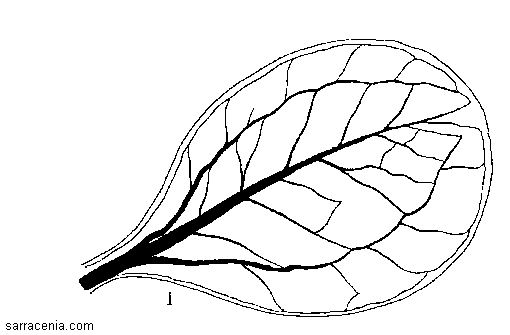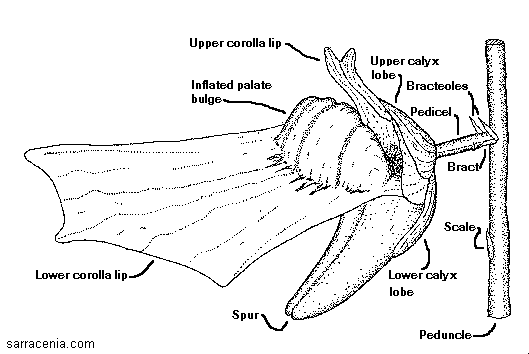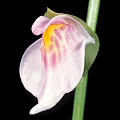Focusing on U. calycifida--a Variable Species
(Carnivorous Plant Newsletter, 1992, 21:1, 9.)
Since Peter Taylor's Utricularia monograph
was published in 1989, learning about
the plants in our collections has become much easier.
But, since the genus is large and globally widespread,
the monograph is technical and expensive and
not likely to be in every grower's library.
The result is many carnivorous plant enthusiasts don't have a way to get to
the valuable information in Taylor's work.
This is why I'm writing the Focusing on Utricularia articles--to
present parts of Taylor's work to carnivorous plant enthusiasts.
Each installment of this series will be about a different species,
a species commonly in cultivation but not
illustrated in CPN or other easily accessible sources.
I'll try to include enough of a description of each species so
you can verify the identification of your plant if you think
you're growing it. Space allowing, I'll include a photograph or
two. I already have the next few articles planned, but if I hear of much
interest in a particular species I can put it in the queue.
With 214 species of Utricularia described,
identifying a plant can be hard. Often a very good (or the best) way
may involve microscopic details--the precise
nature of the bladders, seed coats and such. I'll avoid these
details and spend most of my time on the macroscopic features of
the plants--leaves, flowers, or features that can be seen with
a magnifying glass. If you grow the plant being discussed,
aggressively compare my description to your specimen. Since the time
the ancestor of your plant was originally field collected,
its descendents may have passed through the hands of
many growers, and could have become mislabelled on the journey. Treat
the name tags in your pots with a healthy skepticism. It is very
helpful if you know the country from which your plant (or its ancestor) was
collected. If you have this information for your plants, record it.
 Species of Utricularia can
be variable. Not only can one clone be different
from another, but the same plant can produce wildly different
leaves and flowers under differing conditions. As an example,
consider U. subulata--a weed in my plant collection.
Sometimes the flowers on my plants are cleistogamous--forever
pale white, small and
budlike--and are produced on short erect inflorescences. Meanwhile,
a U. subulata pot next to it may be producing
many brilliant orange-yellow flowers several millimeters long on lanky
inflorescences that eventually topple onto other pots. Other
pots have plants producing inflorescences of intermediate form.
In fact, during the year a plant may change among these forms.
Clearly it would be wrong to assign
different species or subspecies names to these different growth habits
(although this has been mistakenly done in the past, e.g.,
"U. cleistogama"). Remember some species are prone to
variation, and just because your plant is producing small flowers
instead of large, or lavender flowers instead of lilac, does not mean
you have a different species. As I said before,
the characteristics that best distinguish
one species from another may not be the flowers alone.
Species of Utricularia can
be variable. Not only can one clone be different
from another, but the same plant can produce wildly different
leaves and flowers under differing conditions. As an example,
consider U. subulata--a weed in my plant collection.
Sometimes the flowers on my plants are cleistogamous--forever
pale white, small and
budlike--and are produced on short erect inflorescences. Meanwhile,
a U. subulata pot next to it may be producing
many brilliant orange-yellow flowers several millimeters long on lanky
inflorescences that eventually topple onto other pots. Other
pots have plants producing inflorescences of intermediate form.
In fact, during the year a plant may change among these forms.
Clearly it would be wrong to assign
different species or subspecies names to these different growth habits
(although this has been mistakenly done in the past, e.g.,
"U. cleistogama"). Remember some species are prone to
variation, and just because your plant is producing small flowers
instead of large, or lavender flowers instead of lilac, does not mean
you have a different species. As I said before,
the characteristics that best distinguish
one species from another may not be the flowers alone.
The tropical U. calycifida is a
good example of variability within a species.
Before I talk about its variable features, let's look at what
most of the forms have in common. The above ground
part of the olive green leaves can be large--easily 5 cm or longer, are
roughly oval shaped, and are semi-erect or lie on the ground.
They are either scattered
helter-skelter on the soil surface or
arranged in a rosette. The largest are fleshy, and
are veined in a complex pattern (Figure 1).
While a leaf is growing its veins may be purplish, but this can fade
as it matures.
The bladders of the plant are small (about 2 mm maximum), and the plant
does not produce tubers.
 In good conditions the plant will produce a thick vertical flower stalk
(peduncle) that is round in cross section near its base.
Often when U. calycifida produces a flower stalk, a second
inflorescence will emerge near the first in about a week.
The upper portion of the
peduncle has subtle grooves and ridges along its length, producing an
almost polygonal cross section.
At maturity it can be more than 20 cm tall and have produced more
than 20 flowers.
The flowers are on short (up to 5 mm) horizontal or ascending pedicels.
In Figure 2 I
have drawn and labelled the parts of an archetypal flower to clarify
my use of botanical terminology.
Where each pedicel branches from the peduncle are three little (1 to
3 mm long) prongs--one bract and two bracteoles. These are
very noticeable on this species. As in all Utricularia
(except for those once classed as genus Polypompholyx),
the calyx is divided into two sepals, or calyx lobes. Looking very closely
(you may need a microscope) you'll notice the
lower calyx lobe is forked at its tip and the sepal margins are
minutely fringed. The name U. calycifida means "split calyx."
Altogether, the pointed bracts, bracteoles, and
fringed calyx lobes remind me of some sort of warrior or
armoured beastie of Arthurian legend. Each combat equipped flower
glares out over the field of battle-Sphagnum!
Just a few days after each flower matures, it drops off and the
wide sepals clasp together to protect the developing fruit.
In good conditions the plant will produce a thick vertical flower stalk
(peduncle) that is round in cross section near its base.
Often when U. calycifida produces a flower stalk, a second
inflorescence will emerge near the first in about a week.
The upper portion of the
peduncle has subtle grooves and ridges along its length, producing an
almost polygonal cross section.
At maturity it can be more than 20 cm tall and have produced more
than 20 flowers.
The flowers are on short (up to 5 mm) horizontal or ascending pedicels.
In Figure 2 I
have drawn and labelled the parts of an archetypal flower to clarify
my use of botanical terminology.
Where each pedicel branches from the peduncle are three little (1 to
3 mm long) prongs--one bract and two bracteoles. These are
very noticeable on this species. As in all Utricularia
(except for those once classed as genus Polypompholyx),
the calyx is divided into two sepals, or calyx lobes. Looking very closely
(you may need a microscope) you'll notice the
lower calyx lobe is forked at its tip and the sepal margins are
minutely fringed. The name U. calycifida means "split calyx."
Altogether, the pointed bracts, bracteoles, and
fringed calyx lobes remind me of some sort of warrior or
armoured beastie of Arthurian legend. Each combat equipped flower
glares out over the field of battle-Sphagnum!
Just a few days after each flower matures, it drops off and the
wide sepals clasp together to protect the developing fruit.
The features described are common to
all the clones of U. calycifida I have seen.
The flowers, however, can vary greatly in color, size, and shape.
None are scented, but this might occur in
special or ideal conditions. In general, a
Utricularia corolla can be divided into three main
components: the upper lip, the lower lip, and the spur.
In one of my forms of
U. calycifida the 5-6 mm long upper lip arches close
against the lower lip. It is only
3-4 mm wide where it emerges from beneath the upper calyx lobe,
narrows smoothly to 1.5-2 mm in width, and then abruptly truncates
in a rounded end. The lower lip is longer than the upper, 6-7 mm
long. It is only 3-4 mm wide when it emerges from the calyx lobes,
flares to 4-5 mm wide at mid-length, and then tapers to a point.
The edges of the lower lip are often strongly reflexed or undulate.
Like the upper lip it is pale lilac or white.
The keel-shaped inflated palate bulge is longer than it is wide, and at
its top, nearly hidden by the upper lip,
is an orange-yellow splotch, margined with purple-brown.
Much of the rest of the lower lip
is speckled with small (1/4 mm diameter) purplish-brown spots.
These spots also
occur on the upper lip, but are stretched out into elongated
streaks. The spur, usually paler than the lips,
curves up to almost touch the lower lip at its tip.
I call this form U. calycifida `spotted flower' (Figure 3).
Keep in mind this is not a registered cultivar name, it is just how
I informally refer to the plant. The veins on this plant's
leaves are purple only while the leaves are growing, and
even then the coloration is mild--often purple is completely lacking
in the leaves. This plant self pollinates readily,
and if you let it will infest all of your other pots with viable seeds!
 The second form of U. calycifida I grow
is cultivated by many carnivorous plant enthusiasts
in the U.S. Those that don't know its
specific name call it
U. sp. Venezuela. Even when it is not in flower
it is distinguishable from "spotted flower " because of differences in
its foliage--it produces far fewer but larger
leaves. Also, the veins
on this form are bold and purple for the leaf's entire life
span. I refer to this plant as U. calycifida "purple veins "
(another informal, unregistered name).
The inflorescence of the two forms are similar except in the details of the
corolla. In "purple veins, " the corolla's upper lip is more
erect and is only occasionally horizontal, and both
the upper lip and spur are larger--up to 10 mm long each.
But the chief difference between the flowers of the two forms
is in the lower lip. Up to 1 cm long, the lower lip of "purple veins'
is slightly or clearly
three lobed, not very undulate, and is much wider than in `spotted flower. "
The inflated palate bulge is approximately hemispherical.
The coloration of this form is also different--the entire flower is
lavender, except for a yellow blotch ringed with a very narrow white
zone, located at the crest of the inflated palate bulge.
Altogether, the flowers of
U. calycifida "purple veins " are the larger and more striking of
the two. With excessive temperature, as often found in
terrarium culture, the flowers tend to pale somewhat, especially as
the inflorescence reaches the light fixtures.
This plant produces seeds less commonly than does "spotted flower, " but
I've obtained seed by selfing the flowers.
The second form of U. calycifida I grow
is cultivated by many carnivorous plant enthusiasts
in the U.S. Those that don't know its
specific name call it
U. sp. Venezuela. Even when it is not in flower
it is distinguishable from "spotted flower " because of differences in
its foliage--it produces far fewer but larger
leaves. Also, the veins
on this form are bold and purple for the leaf's entire life
span. I refer to this plant as U. calycifida "purple veins "
(another informal, unregistered name).
The inflorescence of the two forms are similar except in the details of the
corolla. In "purple veins, " the corolla's upper lip is more
erect and is only occasionally horizontal, and both
the upper lip and spur are larger--up to 10 mm long each.
But the chief difference between the flowers of the two forms
is in the lower lip. Up to 1 cm long, the lower lip of "purple veins'
is slightly or clearly
three lobed, not very undulate, and is much wider than in `spotted flower. "
The inflated palate bulge is approximately hemispherical.
The coloration of this form is also different--the entire flower is
lavender, except for a yellow blotch ringed with a very narrow white
zone, located at the crest of the inflated palate bulge.
Altogether, the flowers of
U. calycifida "purple veins " are the larger and more striking of
the two. With excessive temperature, as often found in
terrarium culture, the flowers tend to pale somewhat, especially as
the inflorescence reaches the light fixtures.
This plant produces seeds less commonly than does "spotted flower, " but
I've obtained seed by selfing the flowers.
Cultivation of U. calycifida is easy. It enjoys the conditions
many tropical carnivorous plants like, and is an ideal terrarium subject.
It is not at all picky about temperatures, provided you keep it
warm, around 60-90°F, and in high humidity. For
soil, I use dead or live Sphagnum--it is a large species so
it usually does not become overwhelmed by live moss as long as
you have fulfilled its other requirements.
If I keep my plants too cool they slow in growth but don't die.
I doubt they could survive a frost well.
If you grow them too warm the flowers are often short lived, pale, and
stunted. The plant's strongest dislike is bright
sunlight--with too much sun it will only produce small leaves that easily
burn. Aphids and scale can be problems, and the best policy is prevention.
If you have an infected plant and can't get
rid of the pests by picking them off it might be best to find a
subterranean, uninfested portion of your plant and start up a new pot.
In the wild the plant is found in shaded wet areas in northern
parts of South America, i.e. Venezuela, Guyana, Surinam, and northern
Brazil. With the recent surge in interest for the flora of these
countries, it is likely new clones of the plant will be
introduced to cultivation. I have already heard of several South
American plants new to cultivation
I suspect are U. calycifida. These new clones may
have flowers with different colors and morphology from the ones I've
described here, but the other characteristics (i.e. leaves, peduncle,
bracts, sepals) are likely to be the same. The dimensions I have quoted
in this article, especially of the flowers, should be viewed as variable.
Under different conditions from mine, the flowers and leaves may be
larger or smaller.
I'm beginning to experiment with selfing
and crossing among the U. calycifida forms I have
to see if the plants will
grow true from seed. These experiments are incomplete
but I'll publish them in a future issue of CPN as a
letter to the editors.
If you grow different forms of U. calycifida side by side, you may
be surprised or skeptical that they are the same species--I
know I was. However, Peter Taylor himself examined
specimens I sent him and verified they were
U. calycifida. I hope botanists will study the
populations of these plants in the wild--perhaps some day the species
will be split into two or more species or subspecies. Until then, they
are all considered forms of one interesting polymorphic species.
I thank Don Schnell and Peter Taylor for
comments and criticisms useful in the preparation of this
article. I also thank Peter
Taylor for examining my specimens of Utricularia.
Postscripts:
1: In CPN
I have also obtained from Christoph Belanger a few other clones of this
plant, especially one ("Mauve flower") which has foliage the same as
"Purple veins" and similar large flowers. The lower lip of
its flowers has a reticulated pattern in the proximal palate region
similar to the spots on "Spotted flower."
I consider "Mauve flower" to be a plant intermediate
between "Purple veins" and "Spotted flower." In this perspective, it
argues against a
species or even subspecies distinction for those two U. calycifida
forms. Lastly, I have also obtained a form which has white flowers with a
yellow patch on the proximal palate region.
2: Since publishing this article, I have established cultivar names for all the types described in this
article. Also, I successfully crossed the various forms and produced seed.